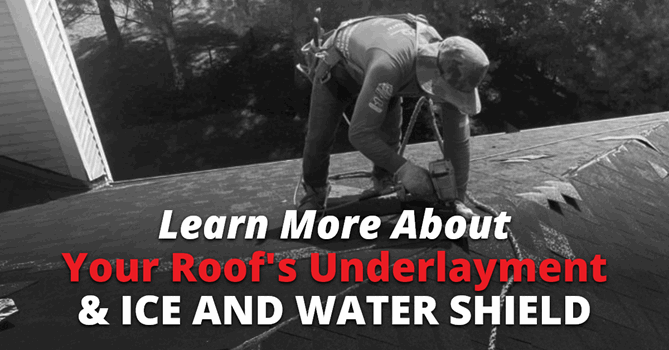Learn More About Your Roof's Underlayment & Ice and Water Shield

Your roof goes beyond the shingles you see. It is a complete system of different components working together to keep your home dry and protected from the elements. Many homeowners aren't familiar with the less apparent components for a sturdy and reliable roof, such as the roof underlayment and ice and water shield.
To help you make informed decisions regarding roof replacement or repair, we'll be covering the information you need to know about your roof's underlayment and ice and water shield.
What is Roofing Underlayment?
Roofing underlayment is a water-resistant or waterproof protective layer directly placed on a roof deck before installing any other roofing materials. The underlayment is one of the main ‘hidden’ components of your roofing system.
Why Roof Underlayment is Necessary
- Moisture Barrier: Wind-driven rain and snow can trap water under shingles, exposing the roof deck, roof framing, and your home's interior to leaks, mold, and water damage. Roof underlayment works as a moisture barrier, allowing water to slide off the surface and providing an extra layer of protection.
- Weather Protection: Shingles are your home's first line of defense from harsh weather conditions. However, they can be lifted by strong winds, exposing your roof deck to water intrusion. The underlayment will provide backup protection after storm damage until the shingles are repaired or replaced.
- Uniform Look: The underlayment provides a smooth, uniform surface for your shingles to rest on.
Types of Roof Underlayment
- Asphalt-Saturated Felt – This is the oldest type of roof underlayment. Commonly known as “felt paper” or “tar paper,” asphalt-saturated felt is made from varying blends of natural plant fibers (cellulose), asphalt (bitumen), and polyester. The base layer is drenched in asphalt to make it water-resistant. Asphalt-saturated felt comes in two different thicknesses: 30-pound and 15-pound. The heavier felt is more resistant to damage and has a longer lifespan.
- Non-Bitumen Synthetic – Non-bitumen synthetic underlayment has a base mat which is also saturated with asphalt for water-resistance properties. Fiberglass is added to give the product exceptional tear-resistance, stability, and elasticity. Non-bitumen synthetic underlayment is highly flexible, durable, waterproof, and mold-resistant. It is resistant to UV exposure, exceptionally lightweight, and long-lasting.
- Rubberized Asphalt Underlayment – Rubberized Asphalt underlayment provides the most protection and is one of the most expensive underlayment types. It contains a higher concentration of asphalt polymers and rubber, making it waterproof. Rubberized roofing underlayment is waterproof, flexible, and resistant to UV rays.
What is Ice and Water Shield?
Ice and water shield is a secondary waterproof underlayment which protects your roof from ice and water damage. The primary role is to protect the wooden roof deck if water gets underneath the roofing material.
Ice and water shield is made with polymer-modified bitumen, which provides a watertight seal beneath the roofing material. The product looks like a long sheet of sticky black plastic with a slip-resistant top surface for better traction during installation. It has an adhesive back surface, which will bond to the roof deck and form watertight end laps and side laps when applied. The adhesive is self-sealing, which means it's designed to seal at every nail penetration. It will not let any water or ice penetrate.
The Importance of Ice and Water Shield
An ice and water shield is typically required for vulnerable areas, including valleys, low-slope areas, chimneys, and eaves. There are two significant risks your roof experiences without an ice and water shield: wind-driven rain and ice dams.
An ice and water shield reduces the likelihood of wind-driven rain infiltrating the roof surface and causing a leak or forming an ice dam. Damage caused by wind-driven rain isn’t covered by most homeowners' insurance policies. So, having an ice and water shield should be paramount when replacing your roof.
Ice Dams
Ice dams are ridges of ice at the edge of a roof. They form because of snow's continuous melting and freezing due to heat escaping from the house. Ice dams form when the roof surface is too warm due to poor ventilation and insulation.
As the snow melts, it freezes again when it reaches colder edges of the roof, causing a buildup of ice. Over time, the melting water is forced under the shingles where it soaks the roof deck. This results in significant water damage as the water makes it inside your home. An ice and water shield is an effective solution for this problem. It helps water drain safely off the roof instead of working its way into your home. Whether you're embarking on new construction or considering a roof replacement, the roofing experts at Couto Construction can help answer specific questions you have about the structure of your roof and our preferred products. Contact us today to get a free estimate and get the leak protection you need to keep your home dry and comfortable.